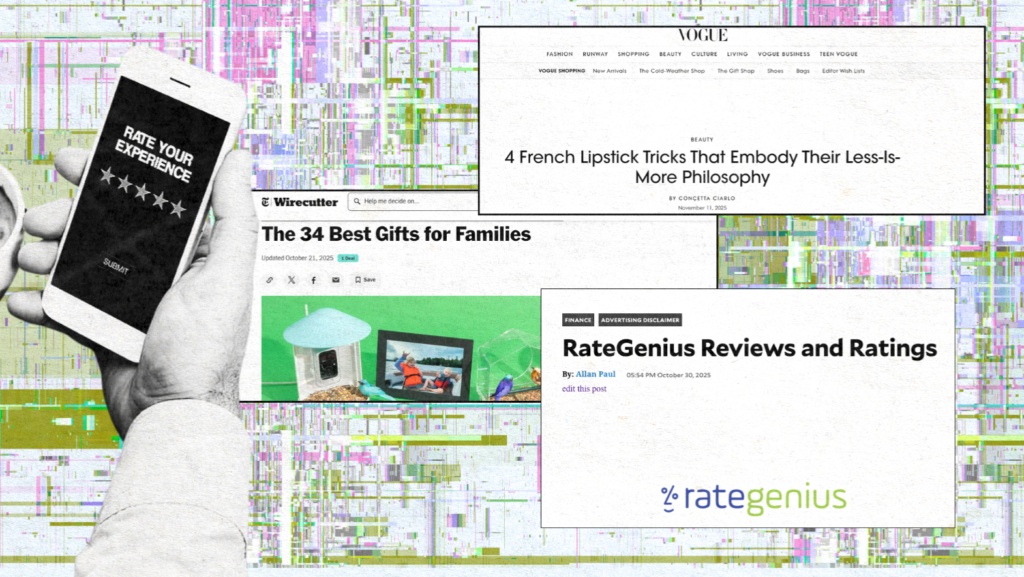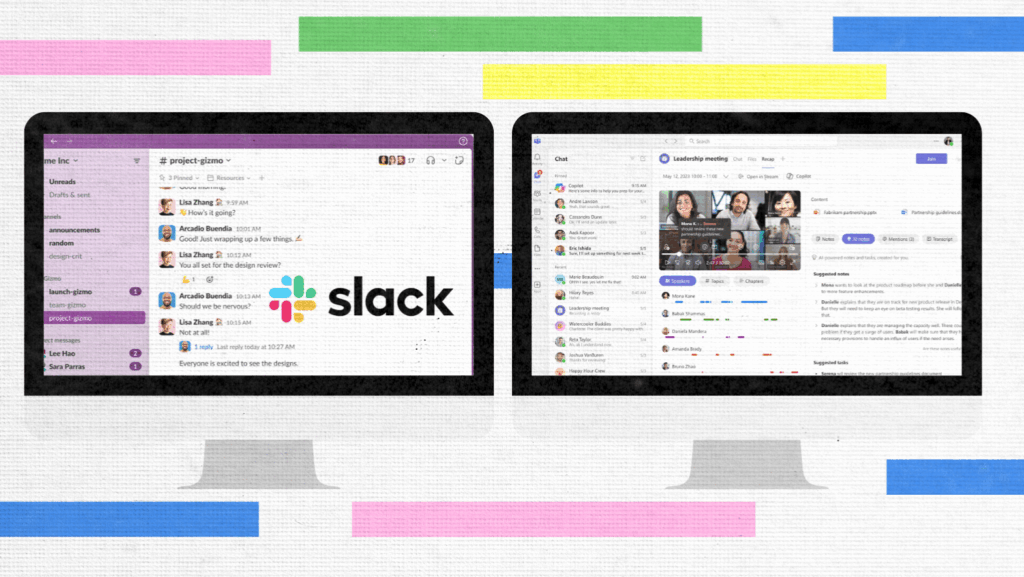Choosing between Shopify and Squarespace isn’t just about picking a website builder—it’s about your entire business future. In 2025, with ecommerce reaching $8 trillion globally and AI tools transforming the landscape, the Shopify vs. Squarespace decision matters more than ever. This isn’t your typical Squarespace comparison of pricing plans and pretty templates.
We’re getting real about costs, scalability, AI features, and which ecommerce platform actually helps you grow. Whether you’re launching your first online store or ready to scale beyond what you’ve built, this guide breaks down everything you need to know.
TL;DR
Shopify is built for ecommerce growth, while Squarespace focuses on design and simplicity.
Shopify offers advanced tools, integrations, and scalability for serious online stores.
Squarespace is ideal for creatives and small businesses that prioritize visuals.
Shopify becomes more cost-effective as your store grows in sales and volume.
Squarespace stays simple but limits features like variants, automation, and scaling.
Goal: Choose Shopify for growth and flexibility — Squarespace for beauty and ease.
Shopify vs Squarespace at a Glance
Here’s the quick breakdown of both platforms before we dive deep into the details:
| Feature | Shopify | Squarespace |
| Best For | Serious ecommerce businesses, scalers | Creatives with simple stores |
| Strength | Superior ecommerce features, unlimited growth | Beautiful design, drag and drop ease |
| Product Variants | Up to 100 per product | Limited options |
| Apps & Integrations | 10,000+ in the Shopify App Store | ~100 integrations |
| POS System | Full retail solution (Shopify POS) | Basic payment tools |
| Scalability | Launch to enterprise | Solopreneur to small business |
| AI Tools | Shopify Magic for commerce | Blueprint AI for design |
Bottom line? Choose Squarespace if you’re a photographer, consultant, or lifestyle brand prioritizing aesthetics and simplicity. Shopify wins when you’re building a real ecommerce business that needs to scale, sell across channels, or handle complex product catalogs.
Both Shopify and Squarespace serve different masters—one’s a selling machine, the other’s a beautiful site that happens to sell.
Pricing and Total Cost of Ownership
Let’s talk actual numbers, because Shopify pricing versus Squarespace pricing gets complicated fast once you factor in the real costs of running an online store.
The Base Plans
Shopify plans breakdown:

- Basic: $19/month
- Grow: $49/month
- Advanced: $299/month
- Plus: $2,300/month
Squarespace plans structure:
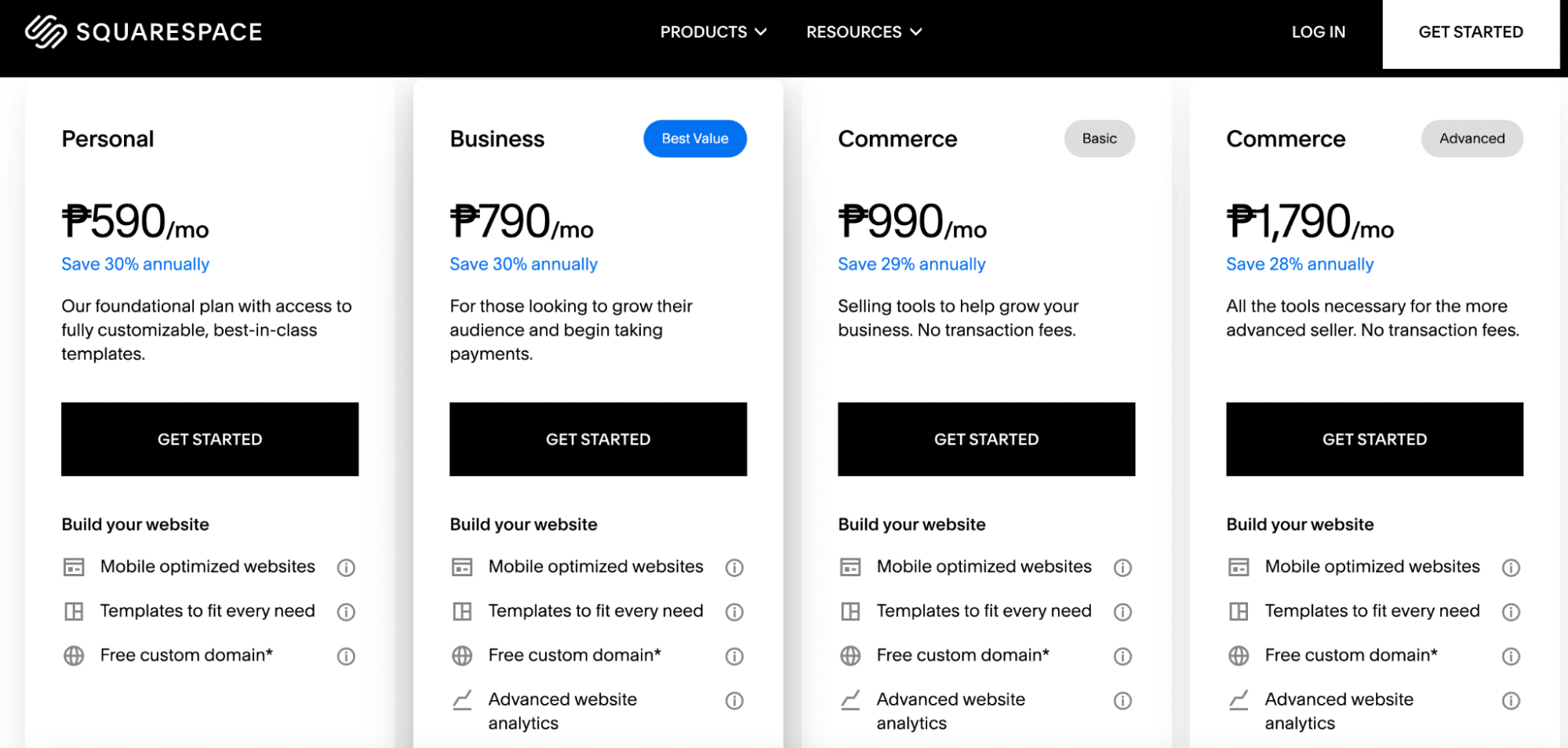
- Personal: $590/month
- Business: $790/month
- Commerce Basic: $990/month
- Commerce Advanced: $1,790/month
At first glance, Squarespace’s pricing appears more affordable. But here’s where things get interesting for store owners.
The Hidden Cost Reality
Transaction fees completely flip the script in this Shopify Squarespace comparison. Squarespace charges 3% on Business plans unless you upgrade to Commerce plans. Shopify charges between 0.5-2% depending on your tier—but here’s the kicker: Shopify Payments eliminates transaction fees entirely. That’s massive for your profit margins as an ecommerce business.
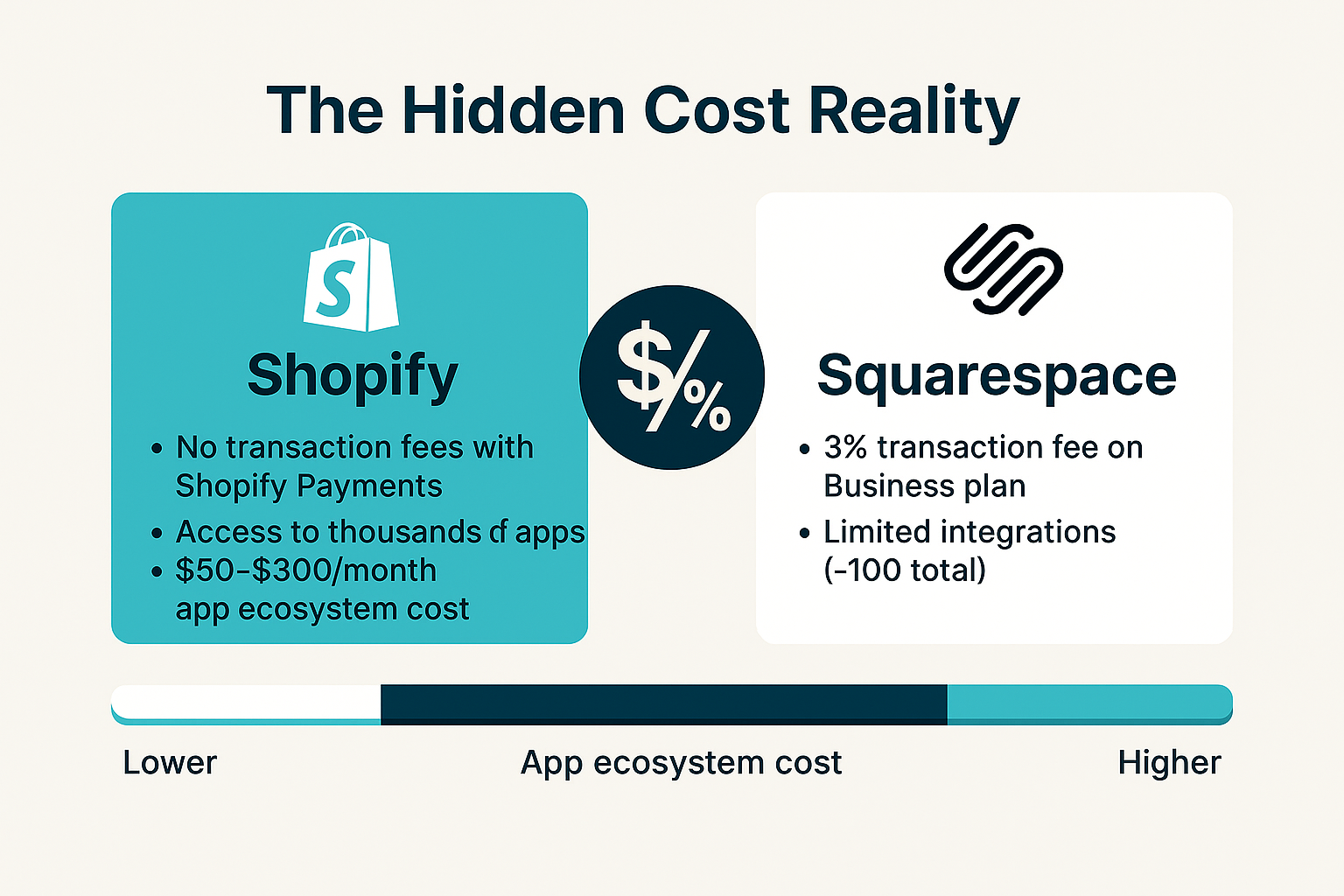
Then there’s the Shopify App Store ecosystem. A growing Shopify store typically spends $50-$ 300 per month on Shopify apps for abandoned cart recovery, advanced analytics, email marketing, and automation tools.
Unlike Squarespace with its limited integrations (around 100 total), Shopify users can access thousands of specialized tools. The flexibility is incredible, but you’ll pay for it as your online store grows.
3-Year Total Cost Reality
Here’s what you’re actually investing over three years:
Small Business (1,000 orders/year):
- Squarespace store: ~$3,200
- Shopify online store: ~$4,100
Medium Business (5,000 orders/year):
- Squarespace: ~$8,500
- Shopify: ~$7,800
Scaling Business (10,000+ orders/year):
- Squarespace: Limited capability, high friction
- Shopify: ~$12,000-18,000 (but supports serious growth)
See that flip at the medium tier? Once you’re doing real volume, Shopify becomes more cost-effective while your Squarespace site struggles with advanced ecommerce features and inventory management. The Shopify vs pricing equation changes dramatically based on your growth trajectory.
Ease of Use and Learning Curve
Let’s be honest about the user experience on both platforms—it matters, especially when you’re just starting out.
A Squarespace website feels like designing a magazine spread. The drag-and-drop editor is intuitive, and gorgeous Squarespace themes make everything look polished instantly.
There’s also zero ecommerce jargon to wade through. For beginners who want their site live by this weekend, Squarespace’s interface is genuinely delightful. You’re building a beautiful website first, with commerce features added on top.

A Shopify store feels like opening a business dashboard. Everything revolves around products, orders, customers, and inventory management from the very beginning. There’s definitely more to learn upfront—you’re navigating shipping zones, payment gateways, and product variants.
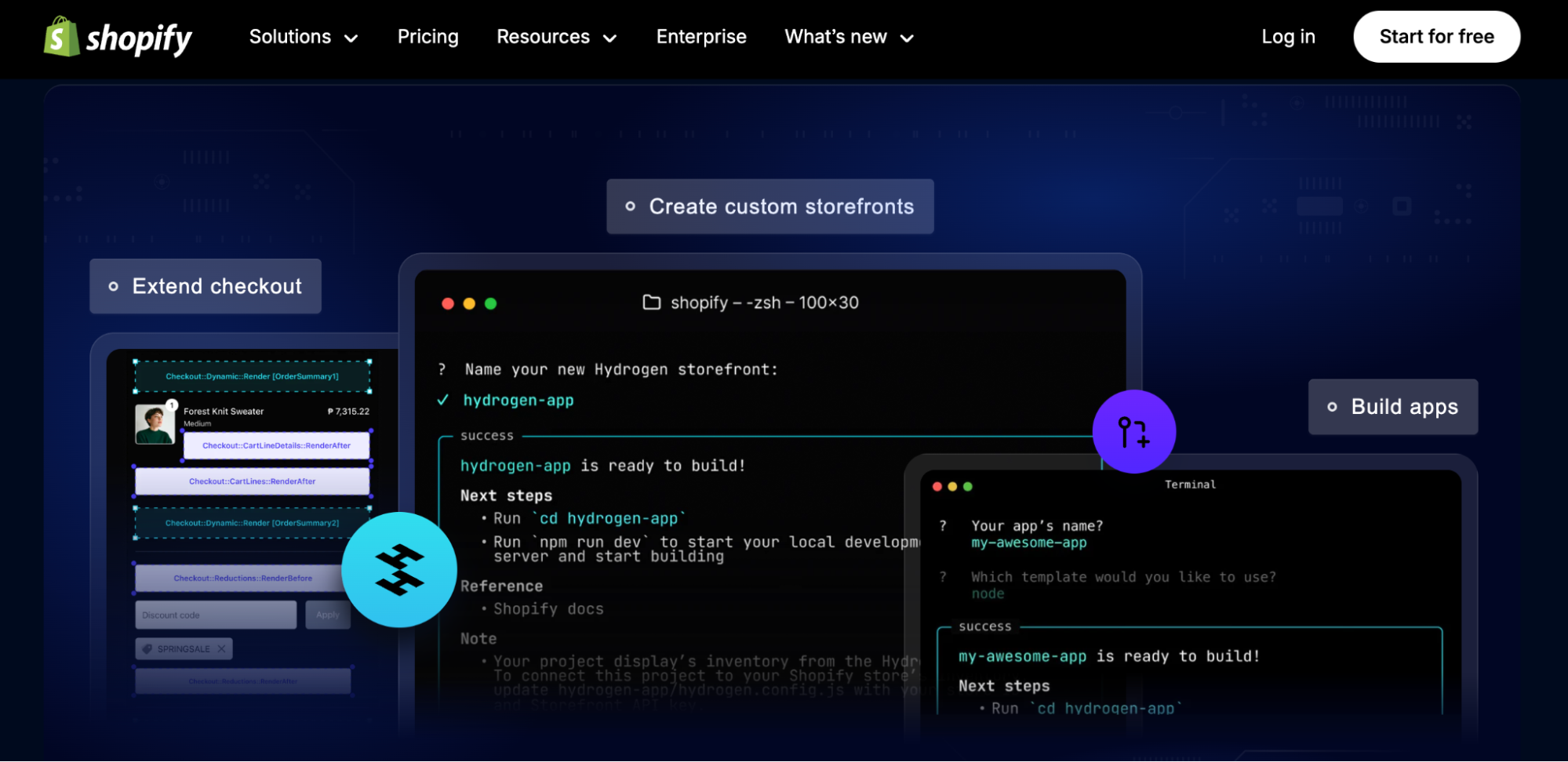
But here’s why that matters: you’re accessing important ecommerce features immediately that your Squarespace store would need workarounds to handle.
The Real Trade-Off
Squarespace’s simplicity becomes limiting as you grow. Unlike Shopify, you can’t easily handle complex product variants (think clothing with multiple size and color options), bulk edit hundreds of products, or set up sophisticated automated workflows. Squarespace lets you start fast and look amazing, but it caps your ceiling as an ecommerce business.
Shopify’s steeper learning curve pays dividends. Features that seemed overwhelming initially—like multi-location inventory or wholesale pricing—become invaluable tools when you’re ready for them. Shopify users often say the platform “grows with you” in ways that Squarespace doesn’t.
- Choose ease over power when: You’re validating an idea, running a side hustle, or commerce is secondary to your creative portfolio.
- Choose power over ease when: This is your primary income, you’re managing diverse catalogs, or you have clear growth plans for your online store.
The Aesthetic Battle
Squarespace themes are objectively stunning—we need to give credit where it’s due. They’re created by award-winning designers and optimized for visual storytelling. You get gorgeous galleries, elegant typography, and layouts that make products look aspirational.
For fashion brands, artists, wedding photographers, and lifestyle businesses where aesthetics literally drive sales, Squarespace offers unmatched beauty straight out of the box.
The Shopify Theme Store is more functional than fancy. Templates are optimized for conversion over pure beauty—clear product information, streamlined checkout flows, mobile-first commerce.
Yes, premium themes can look stunning, but Shopify’s design philosophy serves the transaction first, not the portfolio. Unlike Squarespace, Shopify assumes you’re building a store, not a gallery that happens to sell.
AI-Powered Design in 2025
Both platforms are racing into AI territory with distinct approaches:
Shopify Magic (powered by their AI assistant Sidekick) handles:
- Product description generation from images
- Workflow automation suggestions
- Email subject line optimization
- Inventory forecasting based on trends
- Pricing strategy recommendations
Blueprint AI and Squarespace AI focus on:
- Layout optimization based on your content
- Design suggestions for visual coherence
- Content generation for pages and blogs
- Image enhancement and adjustments
Shopify Magic feels commerce-focused because it leverages data from millions of Shopify stores and billions in transactions. Squarespace AI emphasizes beautiful website creation and visual harmony. Both are investing heavily in AI tools, but their priorities reflect their core audiences.
When You Outgrow Templates
Eventually, successful businesses want custom functionality. Working with a Shopify developer opens unlimited possibilities through Liquid templating and extensive APIs. The Shopify partner ecosystem includes thousands of experts who specialize in custom builds.
Unlike Shopify, Squarespace offers code injection, but limits the depth of modification to core functionality. For businesses hiring developers or planning advanced customization, Shopify offers exponentially more flexibility as an ecommerce platform.
eCommerce Features and Scalability
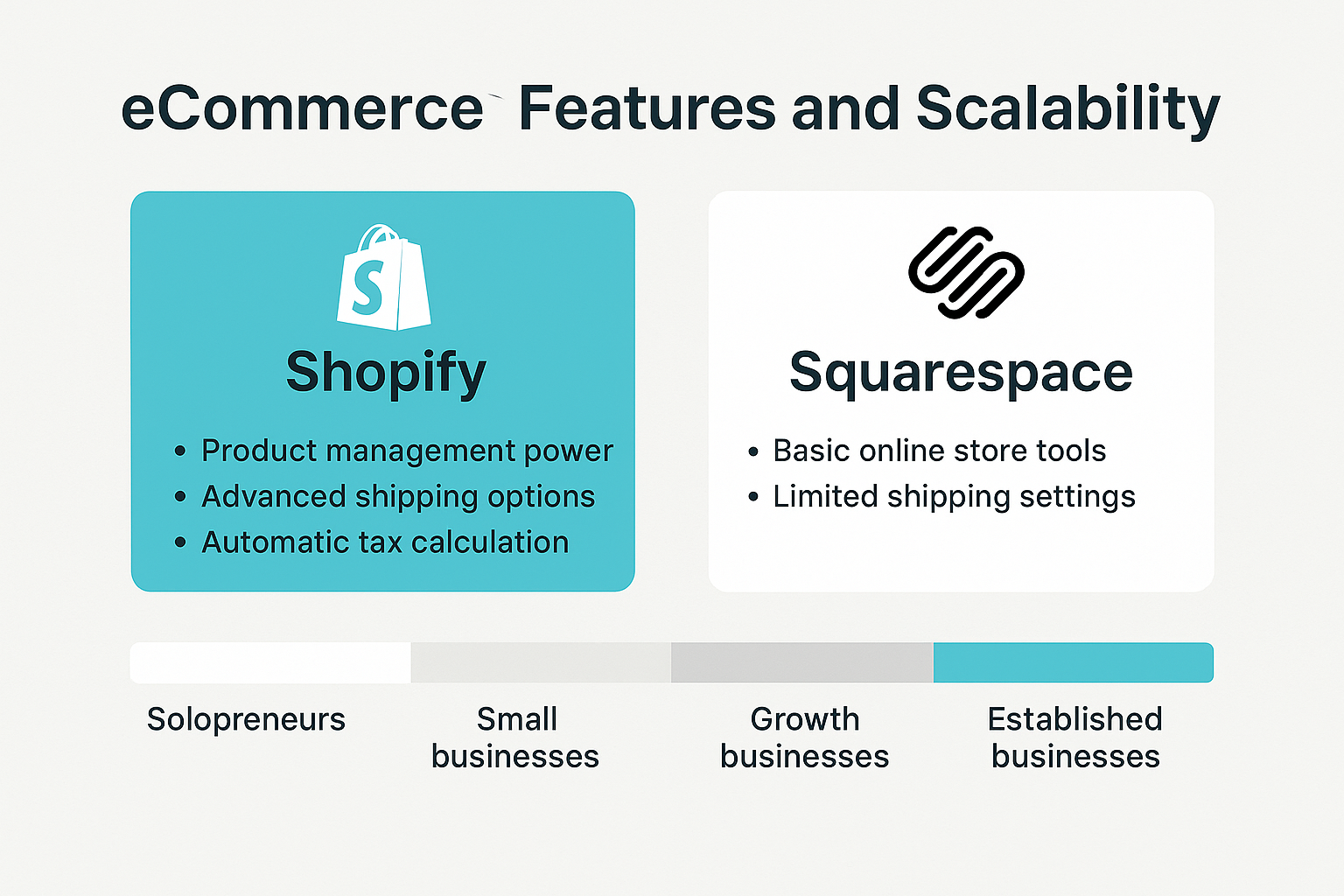
This is where the Shopify vs Squarespace debate becomes pretty one-sided, honestly.
Product Management Power
Shopify handles complexity like a pro:
- Unlimited products with up to 100 variants each (size, color, material, etc.)
- Multi-location inventory management across warehouses, retail stores, and pop-ups
- Native subscriptions, product bundles, and digital goods
- Bulk editing tools for managing catalogs of hundreds or thousands
- Advanced sales tools for wholesale, B2B, and retail pricing tiers
- Metafields for custom product data
Squarespace keeps it basic:
- Variant limitations that frustrate clothing and accessory retailers
- No native subscription functionality without workarounds
- Basic inventory management—manual for the most part
- Unlike Shopify, it lacks sophisticated product organization tools
For a Squarespace store, managing even 50 products with multiple variants becomes tedious. A Shopify online store handles 5,000+ products smoothly.
Shipping & Fulfillment
Shopify shipping capabilities include:
- Negotiated carrier discounts (up to 88% off USPS, 70% off UPS rates)
- Real-time shipping rate calculations at checkout
- Label printing and tracking integration
- Automated fulfillment workflows
- Integration with ShipBob, Amazon FBA, and other fulfillment networks
- International duties and customs calculations
Squarespace offers basic flat-rate or weight-based shipping. You’ll manually configure most rates and handle fulfillment partnerships yourself—a significant limitation for growing ecommerce businesses.
Tax & Compliance
Here’s something store owners often overlook until it becomes a problem: tax compliance.
Shopify automatically calculates and collects sales tax for all US states based on nexus rules, handles VAT for European markets, manages GST for Australia, and supports tax reporting. It’s not just convenient—it keeps your ecommerce business legally compliant as you expand.
Unlike Shopify, Squarespace covers tax basics but requires extensive manual configuration for multi-state or international complexity. This becomes a real headache for Squarespace vs Shopify users once they start scaling.
The Scalability Reality
Solopreneurs (under $10K/year): Both Squarespace and Shopify work fine, choose based on priorities
Small businesses ($10K-$100K/year): Both viable, but Shopify offers more room to grow
Growth businesses ($100K-$500K/year): Shopify wins significantly with superior ecommerce features
Established businesses ($500K-$5M): Shopify Plus territory; Squarespace isn’t built for this
Enterprise (millions): Shopify only; Squarespace caps out functionally
Performance, Speed, and Security
Let’s talk about something that directly hits your bottom line: site performance and reliability.
Loading Speed Matters

Speed equals money. Studies consistently show that one-second delays in page load time decrease conversions by 7%. Shopify stores load in 1.5-2 seconds on average with proper optimization. A Squarespace website typically hits 2-3 seconds—noticeably slower, especially on product-heavy pages with multiple images.
This gap widens on mobile devices, where Shopify’s commerce-optimized infrastructure shows clear advantages. For search engines, site speed is a ranking factor, so this impacts both conversions and SEO for your online store.
Security Infrastructure
Both platforms handle the essentials: SSL certificates, PCI DSS compliance for payment processing, and basic fraud detection. Shopify leads the way with more sophisticated fraud analysis, powered by data from millions of Shopify users worldwide. The platform catches fraudulent transactions before they become chargebacks.
Both support modern payment methods, including Apple Pay, Google Pay, and Shop Pay (Shopify’s one-click checkout). Security-wise, both Shopify and Squarespace are solid choices—neither is a liability for serious ecommerce businesses.
Backup and Reliability
Here’s a frustration: neither platform offers perfect native backups. Shopify relies on third-party Shopify apps (costing $5-20/month) for automated backups. Squarespace offers some automatic backup through their infrastructure, but limited control over restore points.
The upside? Both platforms provide enterprise-grade server reliability. Downtime is rare on either, which matters because every minute your online store is down costs money.
Apps, Integrations, and Ecosystem
This section reveals a massive difference between Shopify vs Squarespace.
The Shopify App Store Advantage
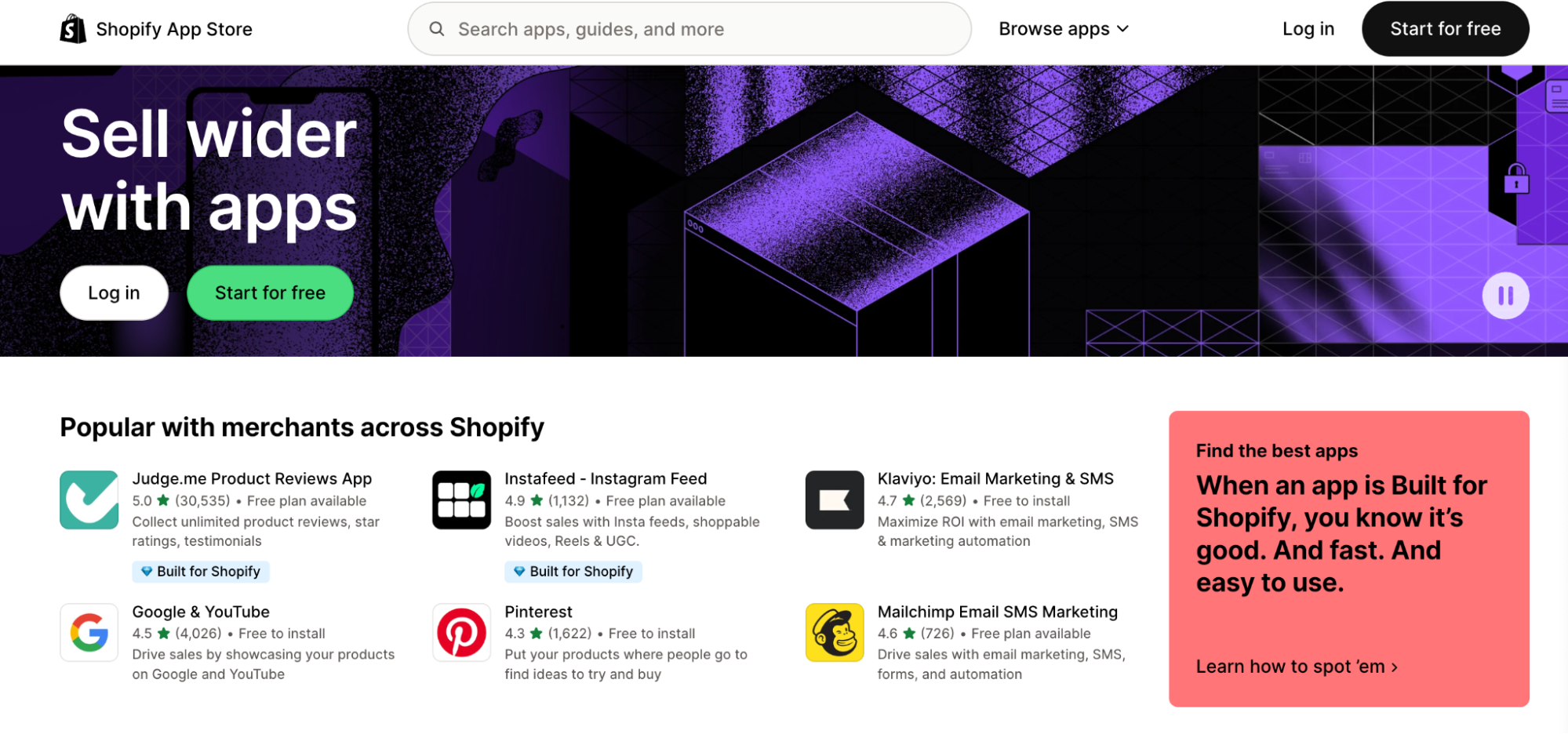
The Shopify App Store hosts over 10,000 apps covering literally every imaginable need for your online store:
- Email marketing: Klaviyo, Omnisend, MailChimp
- Reviews: Yotpo, Judge.me, Loox
- Upselling: Bold Upsell, ReConvert, Zipify
- Dropshipping apps: Oberlo, DSers, Spocket, Printful
- Subscriptions: Recharge, Bold Subscriptions
- Analytics: Better Reports, Lifetimely
- Inventory management: Stocky, TradeGecko
- Plus thousands more
Many Shopify apps offer free tiers; premium options range from $10-300/month, depending on functionality and your sales volume.
Squarespace offers around 100 integrations total—mostly covering basics like email providers, accounting software, and social media. Unlike Shopify, which built an entire ecosystem, Squarespace provides curated but limited options.
Multi-Channel Selling
This is where Shopify offers truly shine:
- TikTok Shop integration for viral social commerce
- Amazon and eBay channels for marketplace selling
- Facebook Shops and Instagram Checkout with seamless inventory syncing
- Pinterest Shopping with automatic catalog updates
- Wholesale channel with custom B2B pricing
Unlike Squarespace, which handles basic social integrations, Shopify provides sophisticated multi-channel commerce tools that serious ecommerce businesses need to compete in 2025.
The Cost Reality
Here’s the honest truth about Shopify apps: as you grow, costs add up. A typical Shopify store doing $20K-50K monthly runs:
- Email marketing: $50-150/month
- Reviews and social proof: $15-30/month
- Upsell and cross-sell: $20-40/month
- Advanced analytics: $30-80/month
- Subscription management: $50-100/month
That’s $165-400 monthly on top of your Shopify plans base subscription. Budget for it. The counterpoint? These tools drive revenue growth that massively exceeds their cost for growing ecommerce businesses. A good cart abandonment app alone can recover 10-15% of lost sales.
Marketing, SEO, and Analytics
SEO Tools and Search Engine Optimization
Both platforms provide solid SEO tools fundamentals:
Shopify provides:
- Full control over meta titles, descriptions, and URLs
- Automatic sitemap generation for search engines
- Structured data for rich snippets in search results
- Fast loading speeds (crucial ranking factor)
- Customizable URL structures
- Image alt text and optimization
Squarespace offers:
- Similar meta control and sitemaps
- Clean URL structures by default
- Excellent blogging platform for content marketing
- Built-in SEO checklist
The verdict: Squarespace slightly edges out Shopify for content-driven search engine optimization strategies—think editorial sites, lifestyle blogs, storytelling brands. Shopify wins for product-focused SEO, technical optimization, and site speed that search engines reward.
Both platforms provide solid foundations; your success depends more on content strategy than the website builder you choose.
Email Marketing and Automation
Email separates the platforms significantly:
Shopify: Native Shopify Email exists (basic functionality) but most store owners integrate with Klaviyo, Omnisend, or similar power tools. These leverage customer purchase data for sophisticated segmentation—send different emails to first-time buyers versus repeat customers, cart abandoners versus loyal VIPs.
Squarespace: Built-in email campaigns work decently for newsletters and announcements but lack the ecommerce automation that drives revenue. Unlike Shopify, Squarespace offers limited triggered email based on purchase behavior.
Social Commerce in 2025
Social media isn’t just marketing anymore—it’s a sales channel. Shopify’s deep integration with TikTok Shop, Instagram Shopping, Facebook Shops, and Pinterest catalogs makes it the clear winner for modern social commerce as an ecommerce platform.
Both Shopify and Squarespace let you add Instagram and Facebook integration, but Shopify handle inventory syncing, order management, and customer data across channels seamlessly. Squarespace treats social as marketing, not commerce.
Analytics for Store Owners
Shopify’s built-in analytics track everything that matters: sales by product, customer lifetime value, traffic sources, conversion rates by channel, repeat purchase rates, and more. Advanced Shopify plans unlock even deeper insights.
Squarespace analytics cover website traffic basics and simple commerce metrics (orders, revenue) but require Google Analytics for real depth.
Neither replaces dedicated analytics tools for serious businesses, but Shopify offers more actionable ecommerce intelligence out of the box.
Dropshipping and Point of Sale
The Dropshipping Reality

Shopify dominates dropshipping completely with native integrations:
- Oberlo (Shopify-owned) for AliExpress products
- DSers for advanced AliExpress automation
- Spocket for US and EU suppliers (faster shipping)
- Modalyst for branded products
- Printful and Printify for print-on-demand
Launch a dropshipping store in just a few hours with automated order routing, inventory syncing, and supplier coordination through dropshipping apps. The entire business model is built around Shopify’s infrastructure.
Squarespace doesn’t support dropshipping. Period. Unlike Shopify, which built its ecosystem around various business models, including dropshipping integrations, Squarespace simply isn’t designed for it.
Physical Retail with Shopify POS
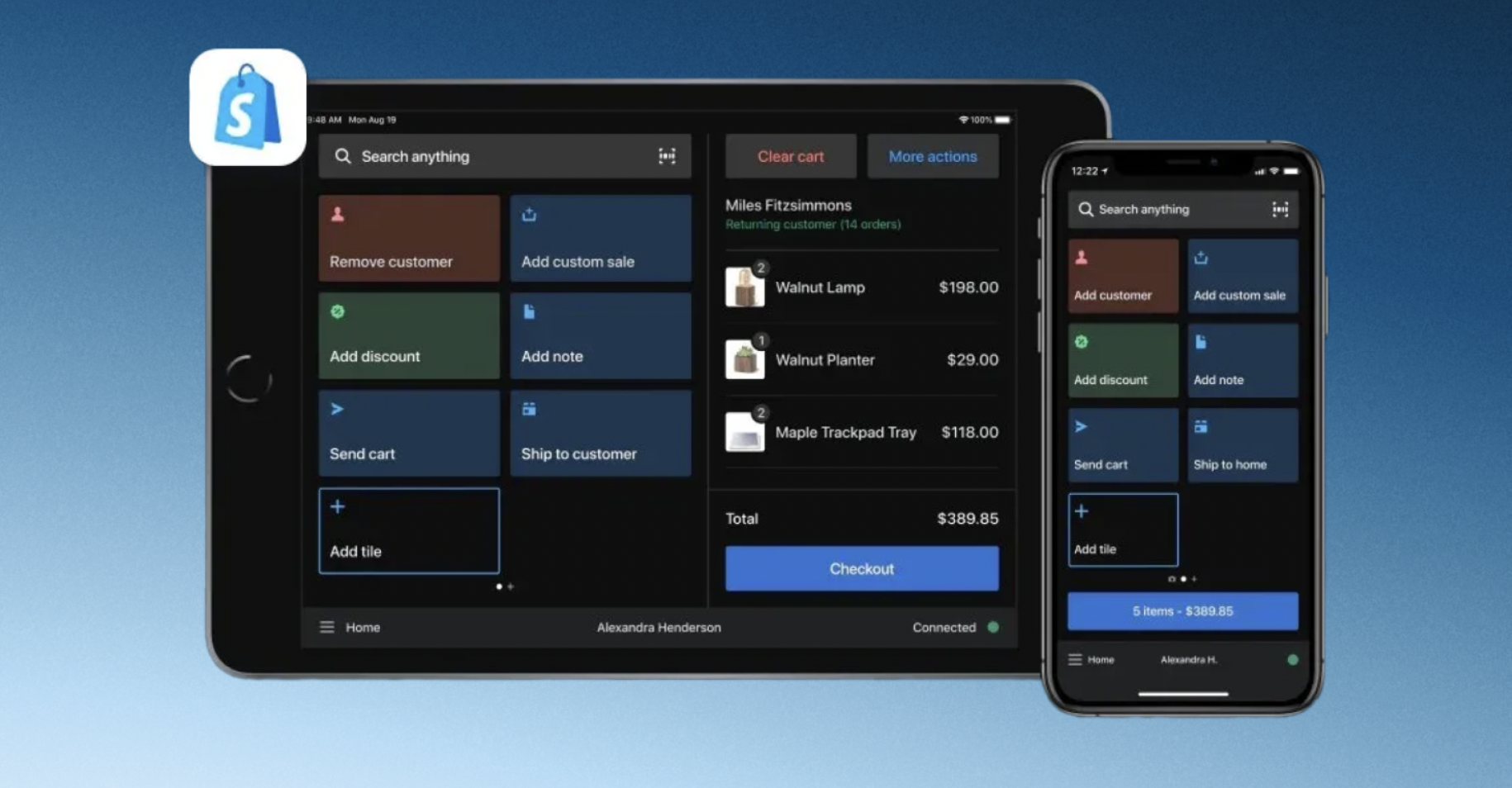
Planning to sell in person? Pop-up shops, farmers markets, retail locations, trade shows?
Shopify POS is a complete retail solution:
- Hardware ecosystem (card readers, receipt printers, barcode scanners, cash drawers)
- Inventory syncing between your online store and physical locations in real-time
- Staff accounts with different permission levels
- Omnichannel customer profiles (see what they bought online when they visit in-store)
- Buy online, pick up in store (BOPIS) functionality
- Apple Pay, Google Pay, and contactless payments
Squarespace offers basic in-person payment tools through Square integration but lacks true omnichannel retail features. Unlike Shopify, Squarespace wasn’t built for sophisticated POS operations that bridge online and offline.

Why Omnichannel Matters Now
Customers in 2025 don’t think in channels—they browse on Instagram, research on your website, buy in your pop-up, and return via mail. They expect seamless experiences. Shopify’s infrastructure supports this reality. Squarespace doesn’t, making it a limiting choice for brands with omnichannel ambitions.
International Selling and Global Commerce
Going global isn’t optional anymore for competitive ecommerce businesses—it’s how you access bigger markets and diversify revenue.
Shopify Markets
Shopify Markets (available on mid-tier Shopify plans and up) handles:
- Multi-currency with automatic conversion based on customer location
- Local payment methods (iDEAL for the Netherlands, Klarna for Europe, etc.)
- International domains (yourstore.co.uk, yourstore.ca for credibility)
- Localized checkout experiences in customer’s language
- Duties and import tax calculation at checkout (huge for customer experience)
- Multi-language stores through translation of Shopify apps
Squarespace offers basic multi-currency switching but requires manual setup for most international features. No native duties calculation, limited localization tools, and significant challenges in managing truly global operations as an ecommerce platform.
Real-World Impact
Here’s a concrete example: You’re a US-based ecommerce business selling to Europe and Australia. You need local currencies, proper VAT handling at checkout, country-specific shipping options, and ideally localized domains for trust.
Shopify handles this natively through Shopify Markets. On a Squarespace site, you’re cobbling together third-party workarounds that create friction at checkout—where friction directly kills conversions. For the Squarespace vs. Shopify decision, international ambitions tip heavily in favor of Shopify.
Migration: Moving from Squarespace to Shopify
Why Businesses Migrate
The pattern is crystal clear: creative businesses launch on Squarespace for the gorgeous design freedom and drag-and-drop ease, then hit a ceiling when commerce becomes their primary revenue driver.
Common migration triggers:
- Hitting variant or product limits with inventory management
- Needing better multi-location inventory management
- Adding wholesale alongside retail operations
- International expansion requirements
- Wanting marketing automation through the Shopify App Store
- Requiring dropshipping integrations, Squarespace lacks
- Needing advanced sales tools for growth
Migration from Shopify to Squarespace is sporadic—usually only when someone pivots away from ecommerce entirely to focus on content or services.
What You’re Actually Moving
Content: Pages, blog posts, images (relatively straightforward with export/import)
Products: Titles, descriptions, prices, SKUs, variants, inventory counts (complex but manageable)
Customer data: Order history, customer accounts, email lists (most critical for continuity)
URL structure: Needs careful planning to maintain search engine rankings
Protecting Your SEO During Migration
The most significant risk is losing search engine rankings and organic traffic you’ve worked hard to build. Here’s how store owners protect themselves:
Essential steps:
- Map every old URL to new ones precisely (use a spreadsheet)
- Implement 301 redirects for every single page and product
- Maintain URL structure where possible to minimize changes
- Keep meta titles and descriptions identical initially
- Don’t migrate during peak season (holidays, significant sales periods)
- Monitor search engines for indexing and ranking changes
Traffic reality: Even with perfect execution and the use of proper SEO tools, expect a temporary 10-20% dip in organic traffic. Most online stores recover within 60-90 days and often surpass previous levels thanks to Shopify’s technical search engine optimization advantages.
Budget and Timeline
Apps like Cart2Cart, LitExtension, and Transporter (available through the Shopify App Store or Shopify partner network) automate much of the data migration process. They’re not perfect, but they handle bulk product and customer transfers well.
Budget $500-2,000 for professional migration help from a Shopify developer or experienced Shopify partner on established stores. The cost of mistakes—lost revenue, broken functionality, SEO drops—far exceeds the investment in doing it right.
Timeline expectations:
- Small stores (under 100 products): 1-2 weeks
- Medium stores (100-500 products): 2-4 weeks
- Large stores (500+ products or custom features): 4-8 weeks
Frequently Asked Questions
Is Squarespace as good as Shopify for online stores?
Which is cheaper in the long run?
Can you integrate Shopify with Squarespace?
Should I migrate from Squarespace to Shopify?
Which platform is better for SEO?
Final Verdict: Shopify vs Squarespace in 2025
If your priority is aesthetics, simplicity, and having a beautiful website with light ecommerce features, Squarespace remains a fantastic option. It shines for creatives, consultants, and service-based brands where online sales are secondary.
But if ecommerce is central to your business, and especially if you plan to scale, expand internationally, or run a complex store, Shopify is the clear winner in 2025. Its unmatched scalability, AI-powered commerce tools, vast app ecosystem, and multi-channel selling capabilities make it a more substantial long-term investment for serious store owners.
Bottom line: Squarespace builds stunning websites that can sell, while Shopify builds powerful online businesses that grow. Your choice depends on whether you’re running a portfolio that sells—or a business built to scale.







